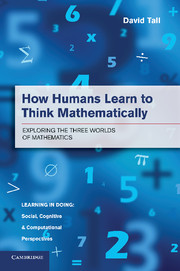Book contents
- Frontmatter
- Dedication
- Contents
- Series Foreword
- Journeys through three worlds of mathematics
- Preface
- Acknowledgements
- Illustration Credits
- I Prelude
- II School Mathematics and Its Consequences
- III Interlude
- IV University Mathematics and Beyond
- 10 The Transition to Formal Knowledge
- 11 Blending Ideas in the Calculus
- 12 Expert Thinking and Structure Theorems
- 13 Contemplating the Infinitely Large and Small
- 14 Expanding the Frontiers through Mathematical Research
- 15 Reflections
- Appendix Where It All Came From
- References
- Index
15 - Reflections
from IV - University Mathematics and Beyond
Published online by Cambridge University Press: 05 June 2014
- Frontmatter
- Dedication
- Contents
- Series Foreword
- Journeys through three worlds of mathematics
- Preface
- Acknowledgements
- Illustration Credits
- I Prelude
- II School Mathematics and Its Consequences
- III Interlude
- IV University Mathematics and Beyond
- 10 The Transition to Formal Knowledge
- 11 Blending Ideas in the Calculus
- 12 Expert Thinking and Structure Theorems
- 13 Contemplating the Infinitely Large and Small
- 14 Expanding the Frontiers through Mathematical Research
- 15 Reflections
- Appendix Where It All Came From
- References
- Index
Summary
Having developed an overall framework for the growth of mathematical thinking, it is time to ask the question ‘Of what value is this general theory to individuals playing a particular role in the teaching and learning of mathematics?’ What does it have to say to teachers of young children, to university mathematicians, to curriculum designers, to theorists in various communities of practice, or to learners themselves?
Learning to think mathematically is a cumulative experience that depends on what has already been experienced and current learning will affect what and how we learn in the future. Even though participants in the teaching, learning and using of mathematics are likely to focus on their particular area of responsibility and expertise, all our actions and effectiveness are part of a much bigger picture.
This chapter provides an overall summary of the whole framework and considers how it relates to other theories, not only in terms of similarities and differences, but also how apparently disparate theories may be blended together to evolve new insights.
Viewing the Whole Theory
The overall growth of mathematical thinking is outlined in Figure 15.1. It is based on the sensori-motor foundation of human thinking through conceptual embodiment and operational symbolism and the increasing sophistication of human reasoning that may later be transformed into the axiomatic formalism of set-theoretic definition and formal proof.
As a child matures, mathematical thinking develops in sophistication, beginning with practical mathematics exploring shape and space and encapsulating operations such as counting into concepts such as number, leading to theoretical mathematics involving definition of concepts and deduction of properties. As mathematical reasoning develops in both embodiment and symbolism, there is a further switch from the study of familiar objects and operations to formal mathematics whose consequences apply to any situation that satisfies the given axioms and definitions.
- Type
- Chapter
- Information
- How Humans Learn to Think MathematicallyExploring the Three Worlds of Mathematics, pp. 402 - 420Publisher: Cambridge University PressPrint publication year: 2013

